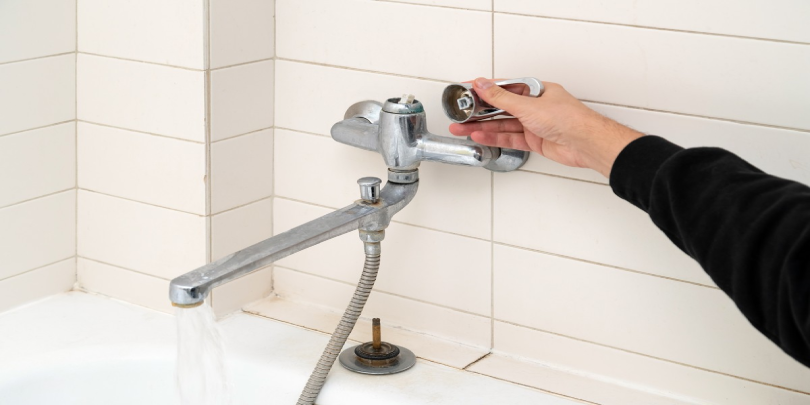
Are drip-drop and the pitter-patter of a leak driving your mutters as its noise constantly interferes with your daily indoor living? Perhaps most of you have become complacent and gotten all but used to the noise pollution of leaky faucets playing in the background subtly like a broken record. And some of you are even convinced that a dripping faucet is inevitable for your sinks and showerheads and, by default, is a side effect of using the plumbing fixture day in and day out. This couldn’t be more false! The truth is your shower faucet is rapidly deteriorating and requires a quick-fix repair to its loose nuts and bolts, such as the shower cartridge or shower valve.
If your shower faucet is starting to deteriorate, as seen by a shower head that is spurting out of control, it’s about time you ask a professional Mississauga plumber for assistance in restoring it to its original condition. But first, you are best advised to educate yourself on the basics of a shower faucet, so you’ll know what the best course of action is moving forward, that is, a shower faucet repair, replacement, or maintenance service.
What Is A Leaky Faucet & Why Should You Fix It?
For many of us, our shower time is our much-needed downtime to relax and unwind and in a sense, it's almost like a ritual in which, apart from cleansing, we are reflecting on our thoughts. Mississauga residents all want to step out of a long, hot steamy shower feeling light, refreshed, and clean–the last thing they need to hear is a dribble of a leak. Although a leaky shower faucet is commonplace, you’d be surprised at how many homeowners let it run its course and become indifferent to fixing it. Responsible Mississauga property owners, however, know the repercussions besides the nosiness of a leak, as they understand a broken shower faucet that is leaking can result in skyrocketing monthly utility bills if the faucet is not repaired. Picture this, for example, if your shower faucet leaks even a few times per minute, it can add up as there are around 15,100 drips per gallon of water! Atop this, you are compromising on the structural integrity of your home’s plumbing system as a leaky faucet is a cause for concern as it may have to do with deeper underlying issues such as a nasty clog. Left unaddressed, the clog can block out your freshwater supply lines and wastewater disposal lines and even lead to the worst-case scenario of a sewage backup in which your home’s used and dirty wastewater is hurled back into your basement and through your plumbing fixtures, including your shower head. Lately, if you notice telltale signs, including fluctuating water pressure levels, mold and mildew growth, sediment buildup from calcium and limescale deposits, damp patches or warped areas on your bathroom’s floor–it’s likely your shower faucet is busted. You are ill-advised to outrightly ignore a shower faucet repair as apart from having an unpleasant shower experience and grooming routine, you are allowing your plumbing system to fall into disrepair. Unfortunately, many homeowners don’t treat a shower faucet leaking akin to a plumbing emergency and procrastinate, only bothering to take action after their shower head is no longer providing a full and consistent stream of water.
Shower Faucet Components
A shower faucet consists of both the shower head and the valve that controls the flow of water and temperature levels, among other things.
Shower Head
The most obvious part of the shower faucet is the shower head which is the main piece from which the water comes out once you turn on the shower. After you turn the handle of the faucet, cold water is transported to the cold pipe, while hot water takes a detour and makes a pitstop in the water heater first. Then altogether, water from both pipes meets at the shower valve, which blends the hot and cool water redirecting it to the shower head or tub spout. There is a diverse palette of shower heads to choose from the generic shower and tub faucet combo to handheld shower faucets, shower-only faucets, and ceiling shower heads. Shower faucets also come in various shapes round, rectangular, or square, alongside various materials, including plastic, metal such as stainless steel, solid brass, chrome, and copper.
Shower Valve
The valve is basically the command center of the shower faucet as it regulates water temperature, water flows out of the shower head, and tub spout, among other things. If anything, it’s one of the essential aspects of your shower faucet, so if it's broken, you may need a shower faucet repair. The are two key types of valves:
Manual Mixer/Pressure Balanced: A manual valve is found as the entry-level option in most older homes. This valve balances water pressure by stabilizing temperature levels. By detecting the volume of hot water compared to cold water, the valve is triggered to deliver water at the chosen temperature. A manual shower allows you to control the temperature level of the water by manually adjusting the valve or handle to the desired temperature for your shower. And so, every time you turn on the faucet with the handle, you are controlling both volume and temperature at the same moment. Because it’s manual, it does not have a safety mechanism that will automatically turn off the faucet if there is a too-hot or too-cold problem; a manual shower cannot react instantly to sudden changes in temperature. A pressure-balanced valve is great for maintaining a stable temperature and is inexpensive to install, but the only downside is that because temperature and volume are directly proportional, it is not possible to, for example, run hot water at a slower-paced flow which you may need to shaving or lathering shampoo better.
Thermostatic: The polar opposite, a thermostat gives you the ability to predetermine and set the desired water temperature and react and adjust to any sudden changes in temperature levels. This is due to there being two controls, one for temperature and another one for volume or pressure. Basically, hot and cold water is mixed to the correct ratio before being fed through the shower head, always allowing for a steady and tepid flow of water. As a convenience, your chosen temperature will be the same the next time you shower and automatically default to the selected setting. The great aspect of a thermostatic valve is that it protects you from the abrupt change in the water supply, so you won’t be off-put if someone flushes the toilet or turns on the kitchen faucet or even dishwasher as the temperature will remain the same. The only downside is it’s the more expensive option.
Water Supply Pipe
Water is transported to the faucet through two pipes, one for hot and cold. One of the pipes runs cooled-off water from the water main and the other runs directly from the water heater, both of which are located beneath the bathtub and usually made of copper, stainless steel, or PVC. If they happen to showcase discolored rust and corrosion, they may be leaking.
Shower Drain/Strainer
A shower drain is affixed between the shower enclosure and drainage pipe and captures water to redirect and transport it to the sewage lateral. A pretty straightforward shower drain system will have all the same drain openings or holes at the bottom area of the shower or underneath the faucet.
Shower Cartridge
A shower cartridge is used to control the amount and flow of water from the faucet. Although a shower valve is an inner device within the wall that regulates water temperature and pressure, a cartridge is external to the shower faucet but serves a similar function. If your cartridge happens to be broken due to a defective rubber ring or other attached parts being damaged, it will result in a leakage. Atop this, there will no longer be moderate pressure between hot and cold water, resulting in random and fluctuating temperatures.
Shower Hose
This is used to connect your shower valve to the shower head and in a wide variety of lengths, it is usually made of plastic or metal and can be installed to resist kinks. If your shower head is leaking, it may be due to a broken shower hose. You can tell because the rubber washers or O-rings that serve as seals between the shower head and hose will be badly damaged. The rubber washers are responsible for preventing water from leaking out, but every time, they deteriorate and need to be replaced.
What Are The Main Reasons For A Leaky Shower Faucet?
Worn Out O-Ring: The O-ring is the small piece located inside the shower faucet spout to prevent leaks and it does so by preventing water from splashing out messily from the spout base. If this part gets damaged, you’ll likely witness water pooling at the base of the shower spout.
Worn Out Washer: As previously mentioned, the washer connects the shower head to the hose, so if you notice a leak, it's a likely culprit that's involved. The washer serves as a safeguard to completely enclose the faucet by closing off openings and stopping any leaks from seeping through. Whenever you turn the shower faucet handle, you create friction against its seat valve, explaining why it becomes loosened up over time from constant use, which of course, results in an eventual leak. Compared to O-rings, washers are more robust and can handle higher pressure levels, and have greater longevity.
Damaged Cartridge Valve: A standard cartridge contains holes that manage the flow and temperature of water each time you turn the handle and offers more direct control than other types of house faucets. This part, too, can become worn out, rusted, or corroded due to sediment buildup and needs to be repaired or replaced to stop leakages.
Corroded Valve Seat: The valve seat is located at the bottom of a shower faucet and is used to turn the water supply on and off. Using its attached washer, it can open and close to allow water to flow through. If your valve seat happens to be damaged, there will be water dripping around the handle area. If you’ve noticed your shower head usually spurts out hard water prickling your skin, or you have felt inconsistent water temperature, it’s likely the valve seat has fallen into disrepair, typically due to mineral and sediment buildup.
Don’t Allow Your Bathtub To Become A Leaky Cauldron–Call Us Today For Leaky Faucet Repair!
Now that you’ve learned about your shower faucet basics with Mr. Handyman’s home improvement 101, you can decide what the best course of action is if your shower faucet is leaking. In the meantime, you may even consider other upgrades to your bathtub or shower area, from shower door installation to tile repair and replacement. A dripping faucet, whether it is your showerhead or spout, is a nuisance and not something you leave on the back burner. Call us today, as one of our customer service representatives is on standby.

